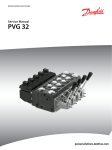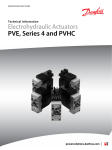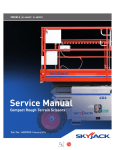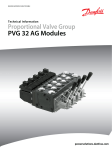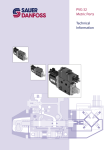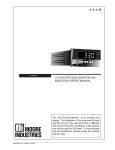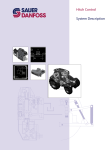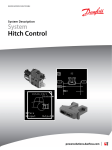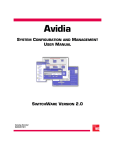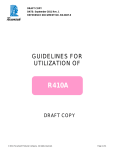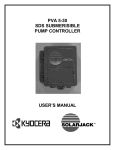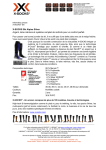Download PVG 32 Proportional Valves Service Manual
Transcript
PVG 32 Proportional Valves Service Manual PVG 32 Service Manual Revisions HISTORY OF REVISIONS Table of Revisions Date Page Changed Rev. November 2012 December 2011 October 2010 March 2010 August 2008 41 41 last last - Revised torque on assembly nuts Revised torque on assembly nuts new back page Fix Osaka address First edition AE AD AC AB AA © 2012 Sauer-Danfoss. All rights reserved. Sauer-Danfoss accepts no responsibility for possible errors in catalogs, brochures and other printed material. Sauer-Danfoss reserves the right to alter its products without prior notice. This also applies to products already ordered provided that such alterations aren’t in conflict with agreed specifications. All trademarks in this material are properties of their respective owners. Sauer-Danfoss and the Sauer-Danfoss logotype are trademarks of the Sauer-Danfoss Group. 2 11039167 • Rev AE • November 2012 PVG 32 Service Manual Contents INTRODUCTION Overview............................................................................................................................................................ 5 General instructions....................................................................................................................................... 5 Safety precautions.......................................................................................................................................... 6 Unintended machine movement........................................................................................................ 6 Flammable cleaning solvents................................................................................................................ 6 Fluid under pressure................................................................................................................................. 6 Personal safety............................................................................................................................................ 6 Hazardous material................................................................................................................................... 6 Acronyms........................................................................................................................................................... 7 OPERATION PVG 32 group with open center PVP (PVB with flow control spool)............................................. 8 PVG 32 group with closed center PVP (PVB with flow control spool).......................................... 8 PVG 32 sectional drawing............................................................................................................................ 9 PVPC plug for external pilot oil supply..................................................................................................10 PVPC with check valve for open center PVP..................................................................................10 PVPC without check valve for open center PVP............................................................................10 Friction detent................................................................................................................................................11 PVMR Friction detent..............................................................................................................................11 PVMF Mechanical float position lock................................................................................................11 PVBS, main spools for flow control (standard)....................................................................................12 PVBS, main spools for flow control (with linear characteristics)...................................................12 PVBS, main spools for pressure control.................................................................................................12 PVPX Electrical LS unloading valve.........................................................................................................13 SYSTEM TROUBLESHOOTING Overview..........................................................................................................................................................14 Troubleshooting a PVG valve....................................................................................................................14 No cylinder/motor response in either direction when remote controller is actuated.........16 Cylinder/motor responds in one direction only.................................................................................16 Main valve spool moves without oil passing to cylinder/motor..................................................17 Cylinder/motor operates without remote controller being operated.......................................18 Cylinder/motor responds slowly to remote electrical or hydraulic controller actuation....19 Erratic cylinder/motor response to electrical or hydraulic controller operation....................19 Hydraulic oil supply......................................................................................................................................20 Electrical supply.............................................................................................................................................21 Hydraulic (remote) pilot control pressure............................................................................................21 11039167 • Rev AE • November 2012 3 PVG 32 Service Manual Contents PVG 32 COMPONENT TROUBLESHOOTING Pressure relief valve......................................................................................................................................22 Pressure reducing pilot valve....................................................................................................................22 Pressure gauge connection.......................................................................................................................24 Open center plug..........................................................................................................................................25 Closed center plug and orifice..................................................................................................................26 Pressure adjustment spool........................................................................................................................27 LS connection.................................................................................................................................................28 LS signal............................................................................................................................................................29 Shuttle valve....................................................................................................................................................30 LS pressure limiting valve...........................................................................................................................31 LS A, B shuttle..................................................................................................................................................32 Main spool.......................................................................................................................................................32 Shock and anti-cavitation valve PVLP....................................................................................................34 Pressure compensator.................................................................................................................................35 Load drop check valve . ..............................................................................................................................36 Maximum oil flow adjustment screws for ports A and B................................................................37 PVM module....................................................................................................................................................38 PVS module.....................................................................................................................................................39 PVPVM module..............................................................................................................................................40 PVAS module...................................................................................................................................................41 PVPX LS unloading valve............................................................................................................................41 PVEH, PVES, PVEA electrical actuators....................................................................................................42 PVEO On/Off electrical actuator..............................................................................................................44 4 11039167 • Rev AE • November 2012 PVG 32 Service Manual Introduction OVERVIEW This manual includes information for servicing PVG 32 valves. It includes a description of the units and their individual components, troubleshooting information, and minor repair procedures. Performing minor repairs may require removal from the vehicle/machine. Thoroughly clean the unit before beginning maintenance or repair activities. Since dirt and contamination are the greatest enemies of any type of hydraulic equipment, follow cleanliness requirements strictly. This is especially important when changing the system filter and when removing hoses or plumbing. A worldwide network of Sauer-Danfoss Global Service Partners is available for major repairs. Sauer-Danfoss trains and certifies Global Service Partners on a regular basis. You can locate your nearest Global Service Partner using the distributor locator at www. sauer-danfoss.com. For specifications and operating parameters on PVG 32 valves, refer to PVG 32 Technical Information Manual 520L0344. Do not attempt to service PVG valves without build sheet specifications for reference. GENERAL INSTRUCTIONS Follow these general procedures when repairing PVG 32 valves. wRemove the unit Chock the wheels on the vehicle or lock the mechanism to inhibit movement. Prior to performing repairs, remove the unit from the vehicle/machine. Be aware that hydraulic fluid may be under high pressure and/or hot. Inspect the outside of the valve stack and fittings for damage. Cap hoses after removal to prevent contamination. eKeep it clean Cleanliness is a primary means of assuring satisfactory motor life, on either new or repaired units. Clean the outside of the valve thoroughly before disassembly. Take care to avoid contamination of the port connections on the valve stack. Clean parts using a clean solvent wash and air dry. As with any precision equipment, keep all parts free of foreign materials and chemicals. Protect all exposed sealing surfaces and open cavities from damage and foreign material. If left unattended, cover the valve with a protective layer of plastic. dReplace all O-rings and gaskets Sauer-Danfoss recommends you replace all O-rings. Lightly lubricate all O-rings with clean petroleum jelly prior to assembly. tSecure the unit For repair, place the unit in a stable position with the shaft pointing downward. Secure the motor while removing and torquing controls, and valves. 11039167 • Rev AE • November 2012 5 PVG 32 Service Manual Introduction SAFETY PRECAUTIONS Always consider safety precautions before beginning a service procedure. Protect yourself and others from injury. Take the following general precautions whenever servicing a hydraulic system. Unintended machine movement W Warning Unintended movement of the machine or mechanism may cause injury to the technician or bystanders. To protect against unintended movement, secure the machine or disable/ disconnect the mechanism while servicing. Flammable cleaning solvents W Warning Some cleaning solvents are flammable. To avoid possible fire, do not use cleaning solvents in an area where a source of ignition may be present. Fluid under pressure W Warning Escaping hydraulic fluid under pressure can have sufficient force to penetrate your skin causing serious injury and/or infection. This fluid may also be hot enough to cause burns. Use caution when dealing with hydraulic fluid under pressure. Relieve pressure in the system before removing hoses, fittings, gauges, or components. Never use your hand or any other body part to check for leaks in a pressurized line. Seek medical attention immediately if you are cut by hydraulic fluid. Personal safety W Warning Protect yourself from injury. Use proper safety equipment, including safety glasses, at all times. Hazardous material W Warning Hydraulic fluid contains hazardous material. Avoid prolonged contact with hydraulic fluid. Always dispose of used hydraulic fluid according to state and federal environmental regulations. 6 11039167 • Rev AE • November 2012 PVG 32 Service Manual Introduction ACRONYMS This table provides a definition of commonly used terms. P = Proportional V = Valve PVP Pump side module PVPV/M Pump side module PVB Basic module PVLA Anti-cavitation valve PVLP Shock and anti-cavitation valve PVS/PVSI End plate PVAS (PVP, PVPV/M) Assembly kit for PVP, PVPV/M PVPX, LS LS Unloading valve PVPC Plug for external pilot oil supply PVBS Main spool PVM Mechanical activation PVMD Cover for mechanical activation PVH Cover for hydraulic activation PVMF Cover for mechanical float PVMR Cover for friction detent PVMR or float position PVEH, PVES, PVEA Electrical activation PVEM Electrical activation PVEO Electrical activation 11039167 • Rev AE • November 2012 7 PVG 32 Service Manual Operation PVG 32 GROUP WITH OPEN CENTER PVP (PVB WITH FLOW CONTROL SPOOL) When the pump starts, and the main spools in the individual basic modules (11) are in the neutral position, oil flows from the pump, through connection P, across the pressure adjustment spool (6) to tank. The oil flow led across the pressure adjustment spool determines the pump pressure (stand-by pressure). When one or more of the main spools actuate, the highest load pressure is fed through the shuttle valve circuit (10) to the spring chamber behind the pressure adjustment spool (6), and completely or partially closes the connection to tank. Pump applies pressure to the right-hand side of the pressure adjustment spool (6). The pressure relief valve (1) opens if the load pressure exceeds the set value, diverting pump flow back to tank. In a pressure-compensated basic module the compensator (14) maintains a constant Pressure drop across the main spool—both when the load changes and when a module with a higher load pressure is actuated. With a non pressure-compensated basic module incorporating a load drop check valve (18) in channel P, the check valve prevents return oil flow. The basic module can have the load drop check valve in channel P for functions with over-center valves. The shock valves PVLP (13) with fixed setting and the suction valves PVLA (17) on ports A and B are used for the protection of the individual working function against overload and/or cavitation. An adjustable Load Sensing (LS) pressure limiting valve (12) can be built into the A and B ports of pressure-compensated basic modules to limit the pressure from the individual working functions. The LS pressure limiting valves save energy compared to the shock valves PVLP. With PVLP all the oil flow to the working function flows across the combined shock and suction valves to tank if the pressure exceeds the fixed setting. With LS pressure limiting valves, an oil flow of about 2 l/min [0.5 US gal/min] flows across the LS pressure limiting valve to tank if the pressure exceeds the valve setting. PVG 32 GROUP WITH CLOSED CENTER PVP (PVB WITH FLOW CONTROL SPOOL) In the closed center version, an orifice (5) and a plug (7) are fitted instead of the plug (4). This means that the pressure adjustment spool (6) only opens to tank when the pressure in channel P exceeds the set value of the pressure relief valve (1). In LS systems, the load pressure flows to the pump regulator via the LS connection (8). In the neutral position the pump control sets the displacement so that leakage in the system is compensated to maintain the set stand-by pressure. When a main spool is actuated, the pump regulator adjusts the displacement to maintain the set differential pressure between P and LS. The pressure relief valve (1) in PVP should be set at a pressure of approximately 30 bar [435 psi] above maximum system pressure (set on the pump or external pressure relief valve). 8 11039167 • Rev AE • November 2012 PVG 32 Service Manual Operation PVG 32 SECTIONAL DRAWING PVP PVB PVB 1. 2. 3. 4. 5. 6. 7. 8. 9. 10. Pressure relief valve Pressure reduction valve for pilot oil supply Pressure gauge connection Plug, open centre Orifice, closed centre Pressure adjustment spool Plug, closed centre LS connection LS signal Shuttle valve 11039167 • Rev AE • November 2012 11. 12. 13. 14. 15. 16. 17. 18. 19. 20. Main spool LS pressure limiting valve Shock and suction valve, PVLP Pressure compensator LS connection, port A LS connection, port B Suction valve, PVLA Load drop check valve Pilot oil supply for PVE Max. oil flow adjustment screws for ports A and B 9 PVG 32 Service Manual Operation PVPC PLUG FOR EXTERNAL PILOT OIL SUPPLY PVPC with check valve for open center PVP PVPC, with check valve, is used in systems where it is necessary to operate the PVG 32 valve by means of the electrical remote control without pump flow. When the external solenoid valve is opened, oil from the pressure side of the cylinder is fed via the PVPC through the pressure reducing valve to act as the pilot supply for the electrical actuators. This means that a load can be lowered by means of the remote control lever without starting the pump. The built-in check valve prevents the oil from flowing via the pressure adjustment spool to tank. Oil Flow Direction With the pump functioning normally, the external solenoid valve is closed to ensure that the load is not lowered due to the pilot supply oil flow requirement of approximately 1 l/min [0.26 US gal/min]. With closed center PVP, the external pilot oil supply can be connected to the pressure gauge connection without the use of a PVPC plug. PVPC without check valve for open center PVP PVPC, without check valve, is used in systems where it is necessary to supply the PVG 32 valve with oil from a manually operated emergency pump without directing oil flow to the pilot oil supply (oil consumption about 1 l/min) Oil [0.25 US gal/min]. Flow When the main pump is working Direction normally, the oil is directed through the PVPC plug through the pressure reduction valve to the electrical actuators. When the main pump flow fails, the external shuttle valve ensures that the oil flow from the manually operated emergency pump is used to pilot open For specifications on PVG 32 valves, refer the over center valve and lower the load. to PVG 32 Technical Information Manual The load can only be lowered using the 520L0344. mechanical operating lever of the PVG 32 valve. With closed center PVP, the external pilot oil supply can be connected to the pressure gauge connection without the use of a PVPC plug. 10 11039167 • Rev AE • November 2012 PVG 32 Service Manual Operation FRICTION DETENT PVMR Friction detent The friction detent PVMR allows the directional spool to be held in any position, resulting in infinitely variable, pressure compensated flow. The spool position will be held indefinitely without the necessity of holding the mechanical lever. PVMR should only be used together with PVB basic modules with pressure compensator. PVMF Mechanical float position lock This allows the float spool to be held in the float position after release of the mechanical handle. PVMF P A F (Standard assembly) P B F (Optional assembly) 11039167 • Rev AE • November 2012 PVMF P B F (Standard assembly) P A F (Optional assembly) 11 PVG 32 Service Manual Operation PVBS, MAIN SPOOLS FOR FLOW CONTROL (STANDARD) When using standard flow control spools, the pump pressure is determined by the highest load pressure. This is done either via the pressure adjustment spool in open center PVP (fixed displacement pumps) or via the pump regulator (variable displacement pumps). In this way the pump pressure will always correspond to the load pressure plus the stand-by pressure of the pressure adjustment spool or the pump regulator. This will normally give optimum and stable adjustment of the oil flow. PVBS, MAIN SPOOLS FOR FLOW CONTROL (WITH LINEAR CHARACTERISTICS) PVBS main spools with linear characteristic have less dead band than standard spools and a completely proportional ratio between control signal and oil flow in the range beyond the dead band. W Warning PVBS with linear characteristic must never be used together with PVEM electrical actuators. The interaction between the small dead band of the spools and the hysteresis of the PVEM actuator of 20% involves a risk of building up a LS pressure in neutral position. PVBS, MAIN SPOOLS FOR PRESSURE CONTROL In a few systems load sensing pump pressure may result in unstable adjustment of the oil flow and a tendency towards system hunting. This may be the case with working functions that have a large moment of inertia or over-center valves. In such systems main spools for pressure control can be advantageous. The spools are designed in such a way that the pump pressure is controlled by the spool travel. The main spool must be displaced until the pump pressure just exceeds the load pressure before the working function is applied. If the main spool is held in this position, the pump pressure will remain constant – even if the load pressure changes – giving a stable system. The use of pressure control spools, however, also means that: • the oil flow is load dependent • the dead band is load dependent • the pump pressure can exceed the load pressure by more than is usual. Due to these factors use pressure control spools only when you know for certain that problems with stability will arise – or already have arisen. Use LSA/B when pressure stability is an issue. 12 11039167 • Rev AE • November 2012 PVG 32 Service Manual Operation PVPX ELECTRICAL LS UNLOADING VALVE PVPX is a solenoid LS unloading valve. PVPX is fitted into the pump side module enabling a connection to be made between the LS and the tank lines. Thus the LS signal can be relieved to tank by means of an electric signal. For a PVP pump side module in open center version the relief to tank of the LS signal means that the pressure in the system is reduced to the sum of the tank port pressure plus the neutral flow pressure for the pump side module. For a PVP pump side module in closed center version, relief to tank of the LS signal occurs when the pressure is reduced by the sum of the tank port pressure for the pump side module plus the stand-by pressure of the pump. C Caution Protect yourself from injury. Use proper safety equipment, including safety glasses, at all times. 11039167 • Rev AE • November 2012 13 PVG 32 Service Manual System Troubleshooting OVERVIEW W Warning This troubleshooting guide for the PVG valve assemblies does not cover valves that have been altered from original valve build specifications TROUBLESHOOTING A PVG VALVE This section provides general steps to follow if undesirable system conditions are observed. Follow the steps listed until the problem is solved. Some of the items will be system specific. Always observe the safety precautions listed in the Introduction section, page 6, and related to your specific equipment. Confirm that valve is built properly according to the specification sheet. If necessary, install a lever to the valve to verify proper mechanical function. Refer to PVG 32 Technical Information Manual 520L0344 for valve configuration information. Refer to PVG 32 Parts Manual 11006794 for part numbers. THINK - before troubleshooting a problem. Every fault location process should follow a logical and systematic order. It is wisest to start at the beginning: • Is the oil level correct when the pump is operating? • Is the condition of oil and filters acceptable? • Are pressure, flow, and flow direction as specified? • Is the oil temperature too high or too low (oil viscosity)? • Are there any unusual vibrations or noise (cavitation)? If the driver of the vehicle is available, ask him: • What type of fault it is and how it affects the system? • How long he has felt that something has been wrong? • If he has “fiddled” with the components? • If he has any hydraulic and electrical diagrams available? Diagrams are often found in the instructions included with vehicles/machines. Unfortunately they are often so technical that they are not of much use in a fault location situation. However; the diagram usually shows the order of, and the connections between, the individual components. When a defective component is identified, clean the component and its surroundings before removal. Remove loose paint from pipes and fittings. Cover all holes, hoses and pipe ends with plugs or seal with, for example, plastic bags after removal to avoid the entry of dirt during repairs. Never disassemble hydraulic components outside. Perform repairs in a workshop on a clean workbench (covered with clean cloth or newspaper). Make sure that a Sauer-Danfoss service manual for with the product is handy. Follow the instructions word for word during disassembly and assembly. If these instructions are not followed closely the system may not operate correctly after repairs are completed. Note that in some cases special tools are necessary for assembling the product. Our service manuals give full guidance on use of special tools. 14 11039167 • Rev AE • November 2012 PVG 32 Service Manual System Troubleshooting Troubleshooting flow chart Problem? Mechanical Mechanical No No No No Hydraulic Hydraulic Electrical Electrical No No Electronic Electronic No No Software P107 823 11039167 • Rev AE • November 2012 15 PVG 32 Service Manual System Troubleshooting NO CYLINDER/MOTOR RESPONSE IN EITHER DIRECTION WHEN REMOTE CONTROLLER IS ACTUATED Cause Verify if fault is mechanical, electrical or hydraulic Sticking main spool Check Corrective action Operate manual lever to confirm mechanical or electrical or hydraulic If moving the manual lever operates the cylinder/ motor check electrical or hydraulic Remove manual, electrical, and hydraulic actuators from the valve section. Remove main spool from valve section and inspected for damage. If no damage reinstall the main valve spool and it should move freely in the valve section bore. Replace the valve module and main spool. If any damage is found on the main spool Check movement of manual lever when electrical controller is operated If manual lever does not move check electrical voltage signal from controller, wiring at the PVE module Internal filters blocked Check movement of manual lever when hydraulic controller is operated If manual lever does not move check hydraulic controller pressure at the PVG valve module - 25 Bar [360 PSI] If none of the above check pump per manufacturers recommended procedure Repair or replace pump per manufacturers recommended procedure Check for blockage in internal filters Remove blockage CYLINDER/MOTOR RESPONDS IN ONE DIRECTION ONLY Cause Check Corrective action Operate manual lever in both directions to confirm if mechanical or electrical or hydraulic If moving the manual lever operates the cylinder/ motor in both directions check electrical or hydraulic If operating the manual lever strokes the cylinder/motor in one direction only, check manual stop screw adjustment Back out manual stop on manual controller and torque the jam not to 8 Nm [70 lbf•in] Do not exceed maximum torque Check movement of manual lever when electrical controller is operated If manual lever does not move in one direction check electrical signal from controller and wiring at the PVE module Check movement of manual lever when hydraulic controller is operated If manual lever does not move in both directions check hydraulic pressure at the PVG module Air in system Entrained air generates heat under pressure Look for foam or bubbles in reservoir. Check for leaks on inlet side of charge pump. Internal leakage Excessive internal leakage may overheat the system. Install loop flushing defeat option and monitor case flow. If case flow is excessive, motor may require major repair. Contact Sauer-Danfoss Service. Shock valves Swap and see if problem follows Replace valves Solenoid actuation If power is OK from controller Repair wiring to PVE module Main spool travel restricted Stop on manual controller turned in too far Back out manual stop on manual controller Remote electrical controller Insufficient signal from electrical controller Repair or replace electrical controller PVEO connections Incorrect PVE/PVEO connections Connect correct way Remote hydraulic controller PVRH Insufficient pilot oil pressure from remote hydraulic controller Pressure needs to be 25 Bar [360 psi] Repair or replace remote hydraulic controller Verify if fault is mechanical, electrical or hydraulic 16 11039167 • Rev AE • November 2012 PVG 32 Service Manual System Troubleshooting MAIN VALVE SPOOL MOVES WITHOUT OIL PASSING TO CYLINDER/MOTOR Cause Check Corrective action Insufficient oil supply to valve Check the pump per manufacturers procedure Repair or replace pump per manufacturers procedure Optional pressure compensator in valve section not functioning Check compensator spool Replace spool Insufficient load pressure at compensator spring chamber LS drilling holes plugged Clean or replace Cylinder/motor load too high for pressure setting of the system Check pressure at the valve If pressure is set to spec. per valve lower load on cylinder/motor Blocked LS galleries Inspect for blockage in LS galleries Remove blockage in LS galleries Shuttle valve faulty Inspect shuttle valve Repair or replace Blocked LS lines to pump controller Inspect LS lines from PCG to pump controller Remove blockage in LS lines from the PVG valve to pump controller Oil bypassing at shock valve/anticavitation check valve Check if stuck open or damaged Replace valve Internal leakage in cylinder/motor Inspect for by-passing of oil per cylinder/motor manufacture per manufactures procedure Repair or replace cylinder/motor per manufactures procedure Too much leakage in LS spool in pump control Check bleed orifice in LS control Use a LS pump control with no bleed orifice Blocked thermal orifice check thermal orifice (blocked) Replace thermal orifice Load too high for system Check for proper system pressure Adjust pressure to valve specification Internal leakage in cylinder/motor Inspect for bypassing of oil per cylinder/motor manufacturer specification Repair or replace cylinder/motor Shock valve or anti-cavitation check valve faulty Inspect for damage and contamination Repair or replace cylinder/motor System relief valve pressure set too low for load Install pressure gauge and check pressure Adjust pressure to system specification Lower load Cylinder/motor load too high for pressure settings of system Check load pressure at PVB-LS port Reduce load pressure if exceeds maximum pressure limit of the system Maximum system pressure should be approx. 25 Bar [365 PSI] above highest load pressure Adjust maximum system pressure if necessary Adjust pump pressure compensator setting if necessary 11039167 • Rev AE • November 2012 17 PVG 32 Service Manual System Troubleshooting CYLINDER/MOTOR OPERATES WITHOUT REMOTE CONTROLLER BEING OPERATED Cause Check Corrective action Spool control tension rod loose Confirm torque on spool control tension rod Torque to 8 Nm [70 lbf•in] Electrical feedback transducer not in neutral position Check the feedback pin in the PVE. It should be loose Replace transducer Remote electrical controller neutral position switch faulty Disconnect the connection at the PVE. It should come back to neutral Repair or replace faulty switch or wiring at remote controller Sticking pressure control valve in remote hydraulic controller Disconnect the hydraulic signal line from valve Repair or replace faulty remote hydraulic controller Sticking main spool in valve section Remove manual, electrical, and hydraulic actuators from the valve section. Remove main spool from valve section and inspected for damage. If no damage reinstall the main valve spool. Spool should move freely in the valve section bore. Replace the valve module and main spool if any damage is found on the main spool Internal fault in the PVE/PVEH/PVEM/ PVEO check continuity. All other PVE, check LED PVEO (Red means internal error) Replace faulty PVE/PVEH/PVEM/PVEO Contamination in the hydraulic oil Flush hydraulic system. Fill with clean filtered oil. 18 Take oil samples to confirm 11039167 • Rev AE • November 2012 PVG 32 Service Manual System Troubleshooting CYLINDER/MOTOR RESPONDS SLOWLY TO REMOTE ELECTRICAL OR HYDRAULIC CONTROLLER ACTUATION Cause Check Corrective action Insufficient system pressure Install pressure gauge and record pressure If pressure is low adjust pressure setting to valve specification or pump manufacturers specification Main spool travel limited Check stops on manual lever controller end for proper adjustment. Refer to Component troubleshooting section, page 22. Adjust the manual lever stops and torque the jam nuts to 8 Nm [70 lbf•in] Do not exceed maximum torque Incorrect signal voltage from electrical controller Check the signal voltage from the controller with a volt meter If signal voltage is incorrect repair or replace electrical controller Incorrect hydraulic pressure signal from remote hydraulic controller Check pressure from the remote hydraulic controller - 25 Bar [360 PSI] If pressure is too low, repair or replace remote hydraulic controller per manufacturers instructions. Insufficient pilot oil - all sections Check pilot for contamination and correctly assembled parts - 10-15 bar [145-218 psi] Electric - 25 bar [360 psi] Hydraulic Replace inlet module NOTE: Check with S-D TST Insufficient LS pump stand by pressure Check pilot PSI - 10-15 bar [145-218 psi] Electric 25 bar [360 psi] Hydraulic Adjust or replace pump Flow is not load independent PVLP check for cracks Check LS pressure vs load pressure Replace valve ERRATIC CYLINDER/MOTOR RESPONSE TO ELECTRICAL OR HYDRAULIC CONTROLLER OPERATION Cause Check Corrective action Electrical actuator faulty Check signal from controller to PVE Repair or replace PVE Main spool centering spring damaged Check tension rod for correct torque or damage Torque to 8 Nm [70 lbf•in] or replace Main spool position feedback transducer signal incorrect Check feedback pin for damage Replace PVE Contamination in hydraulic oil Take oil sample Flush complete system. Fill reservoir with clean filtered fluid per OEM specification Air in hydraulic pilot lines Check for air trapped in signal lines from the controller to the valve section module Bleed air from the hose connection at the valve section Hydraulic remote actuator faulty Check signal pressure from the remote hydraulic controller Repair or replace cylinder/motor Low hydraulic oil supply Check fluid level in reservoir Fill reservoir with clean filtered fluid per OEM specification 11039167 • Rev AE • November 2012 19 PVG 32 Service Manual System Troubleshooting HYDRAULIC OIL SUPPLY Cause Pump not running Check Corrective action Check prime mover for operation Repair or replace prime mover Check condition of drive coupling Repair or replace drive coupling Insufficient oil in reservoir Check fluid level in reservoir Fill with clean filtered oil Leaking or burst supply hose Inspect lines to valve stack Repair or replace damaged hose Relief valve malfunction Check for contamination and operation of relief valve Repair or replace relief valve Isolating valves are closed Check that all isolating valves are open and clear Faulty pump control Check pump compensator for correct operation and setting per pump manufacturers Repair or replace pump compensator per pump manufacturers recommendations Low standby pressure in PVP open center pump Check idle standby pressure - 10 Bar [145 PSI] Replace Check condition of compensator spool spring Replace module due to worn components Low standby pressure in pump control - variable pump Check pump LS control for operation and setting Stand by pressure should be 15 bar [220 psi] minimum Repair or replace LS control per pump manufacturers procedures PVP pressure relief valve faulty Check pressure relief valve spool and spring for freedom of operation Replace PVP orifices blocked Check PVP orifices for blockage Remove blockage Internal filters blocked Check for blockage in internal filters Remove blockage Supply lines blocked Inspect supply lines for blockages Remove blockage Internal hydraulic pilot pressure insufficient Inspect pilot oil pressure reducing valve for proper operation Repair or replace Blocked LS galleries Check LS galleries for blockage Clean blockage from LS galleries Shuttle valves faulty Check LS system shuttle valves for wear and damage Replace as needed Check for contamination per specification HPP 030. Refer to Design Guideline for Hydraulic Fluid Cleanliness, Technical Information Manual 520L0467. If fluid is out of spec., flush hydraulic system and fill with clean filtered oil. 20 11039167 • Rev AE • November 2012 PVG 32 Service Manual System Troubleshooting ELECTRICAL SUPPLY Cause No electrical power Check Corrective action Check electrical circuit Repair as needed Verify emergency stop switch is in the proper operating position Reset Neutral position switch faulty Check operation of neutral position switch in remote controller (if connected in circuit) PVRE/PVRES/PVREL Replace switch Incorrect signal voltage Check voltage levels at solenoid plug Proportional operation - Refer to page 43 Udc: Supply voltage (100%) Us: Supply signal voltage (25-50-75%) Ground: Live or ground connection On-Off Operation Udc: Supply voltage if selected Us: Supply voltage if selected Ground: Live or ground connection Solenoid valve faulty PVHC Check coil resistance Check data for resistance Insufficient pilot supply Check pilot pressure - 10-15 bar [145-218 psi]/PVHC 25 bar [360 psi] Replace Main spool position feedback transducer signal incorrect Test oil for contamination and or water content If oil contamination is too high, flush hydraulic system or replace oil if necessary. If problem persists change PVE Incorrect PVE connections Check that the proportional remote electrical controller has not been connected to an ON-OFF PVEO solenoid Connect wires correctly HYDRAULIC (REMOTE) PILOT CONTROL PRESSURE Cause Insufficient pilot pressure Check Corrective action Check pilot oil pressure 5-15 bar [72-220 psi] delta between A and B port on remote PVG32: 5-15 Bar [72-217 PSI] Insufficient pilot oil supply Check pilot oil flow rate is adequate Pilot flow should be 1.0 L/min [0.264 GPM] per section Check pilot lines for blockage Remove blockage Air in pilot line Check for trapped air in pilot lines Bleed air from pilot lines at PVH Pilot lines incorrectly sized Check pressure drop Check and reduce length or pilot lines Increase diameter of pilot lines Use steel tube for long pilot line runs Hydraulic remote pilot operator faulty Check operation of hydraulic remote pilot controller Repair or replace Check supply pressure to hydraulic remote controller minimum 25 bar [360 psi] Repair or replace Check and inspect movement of pressure control valve in hydraulic controller Repair per manufacturers procedure, or replace Check operation of remote hydraulic controller Clean and/or repair as necessary 11039167 • Rev AE • November 2012 21 PVG 32 Service Manual PVG 32 Component Troubleshooting PRESSURE RELIEF VALVE Description: Adjustable relief valve. Adjustment range 50 Bar [700 PSI] to 350 Bar [5000 PSI]. Location: The relief is in all PVP Inlet modules Function: Provides maximum pressure setting above pump pressure setting 30 Bar [450 PSI] Delta for open center and closed inlet sections Failure mode Cause Corrective action Will not build pressure Contamination While under pressure, back out to minimum pressure and allow oil to leak by for approx. 5 seconds and then readjust to correct pressure - Replace valve External leaking Damaged seat and poppet Replace complete assembly Pressure setting is wrong Pressure adjustment backs off (on open center application) Adjust to model code specification Instability when PC and inlet relief has too low of a delta between them PC at pump should be set 20 bar below relief valve Adjust to model code specification Serviceability: Non serviceable. Valve removal tool P/N: 155L6485. Torque to 20 Nm [180 lbf•in]. PRESSURE REDUCING PILOT VALVE Description: Pressure reducing valve at fixed pressure. Location: The pressure reducing valve is a option in some PVP Inlet modules. Function: Provides 10-15 bar [145-218 psi] internal pressure for electrical (PVE) actuators or provide 25 Bar (360 PSI) (PVHC) and supply for external remote hydraulic actuators (HRC). These pressures are only present when the load pressures are high enough to satisfy the required regulated pressure. The open center system at low pump flow may only develop 9 Bar (130 PSI) 22 11039167 • Rev AE • November 2012 PVG 32 Service Manual PVG 32 Component Troubleshooting PRESSURE REDUCING PILOT VALVE (CONTINUED) Failure mode Main spools are slow, driven by PVE 13 Bar [190 PSI] pilot system Main spools will not move mechanically or electrical PVHC 25 bar [360 psi] pilot system - main spools are slow Cause Corrective action Contamination Disassemble and clean Pump pressure too low - below 9 Bar [130 PSI] Closed center: System increase stand-by to 13 Bar [190 PSI] Open center: Check gear per pump manufacture procedure Check system for other components before valve inlet that may provide a path tank High tank port pressure. Do not exceed 40 Bar [580 PSI] tank pressure (For PVPs without T0 option) Clear restrictions in return system. Oil viscosity 460 mm2/S [2128 SUS] too high (cold oil or incorrect viscosity oil) Warm up system or replace oil with correct viscosity For T0 option only not being connected to tank or restricted to tank Connect T0 (PVP) port option to tank or remove restriction Internal pressure reducing valve parts misassembled Reassemble the internal pressure reducing valve parts correctly Contamination Disassemble and clean Pump pressure too low - below 20 Bar [290 PSI] Closed center: System increase stand-by to 20 Bar [290 PSI] Open center: Check gear per pump manufacturers procedure Check system for other components before valve inlet that may provide a path tank High tank port pressure. Tank pressure should not exceed 40 Bar [580 PSI] (For PVPs without T0 option) Check for restrictions in return system and remove Oil viscosity - 460 mm2/S [2128 SUS] too high (cold oil or incorrect viscosity oil) Warm up system or replace oil with correct viscosity Serviceability: All internal components can be removed from the cavity, cleaned, inspected and reassembled back into the valve 1. Use a 6 mm internal hex wrench to remove the plug, and then remove all the other internal components in the cavity Pressure reducing pilot valve Plug 6 mm 25 Nm [220 lbf•in] O-ring Spool 2. Clean all components with clean solvent Cone 3. Replace any damaged components. Lubricate with clean hydraulic oil 4. Correctly reassemble the components back into the cavity and torque the plug to 25 Nm [221 lbf•in] (use an M5 screw to install spool). 11039167 • Rev AE • November 2012 Spring P107 733E 23 PVG 32 Service Manual PVG 32 Component Troubleshooting PRESSURE GAUGE CONNECTION Description: Port to install a pressure gauge to check pressure relief valve setting to valve specification. Location: On inlet cover to valve stack. 1. Use a 6 mm internal hex to remove and install plug. 2. Torque plug to 35 Nm [308 lbf•in]. Failure mode Leaking Cause Corrective action Bad seal Replace with new seal (same type as original seal) Pressure gauge port Pressure gauge port P107 735E When valve is equipped with the PVPC option use a running tee to measure pressure. Torque tee to hose adaptor torque specification. PVPC with check valve Tee into pressure port to measure pressure PVPC with check valve P107 734E 24 11039167 • Rev AE • November 2012 PVG 32 Service Manual PVG 32 Component Troubleshooting OPEN CENTER PLUG Description: Plug that is installed in the inlet cover for a system with a fixed displacement pump. Location: In the PVP module (Inlet cover). Function: Connection for the load sense signal to shift the unloading spool to build main system pressure and provides a connection to the main system relief valve. Failure mode Valve operates at system relief setting at all times Cause Corrective action Open center plug is not seated properly Reinstall plug and torque to 4 Nm [35 lbf•in] using a 3 mm internal hex wrench Serviceability: Open center plug is serviceable. 1. Use a 6 mm internal hex to remove cavity plug from valve. 2. Use a 3 mm internal hex to remove open center plug. 3. Clean or replace open center plug. 4. Install open center plug. 5. Torque plug to 4 Nm [35 lbf•in]. 6. Install new seal washer and install cavity plug. Torque to 35 Nm [130 lbf•in]. Open center plug Plug 6 mm 35 Nm [308 lbf•in] Seal washer Open center plug 3 mm 4 Nm [35 lbf•in] P107 736E 11039167 • Rev AE • November 2012 25 PVG 32 Service Manual PVG 32 Component Troubleshooting CLOSED CENTER PLUG AND ORIFICE Description: Plug that is installed in the inlet cover for a system with a variable displacement pump. Location: In the PVP module (Inlet cover). Function: Allow connection for the load sense signal to the pump and provide connection to the main system relief valve. Failure mode Cause Corrective action Valve operates at system relief setting at all times Plug and orifice are not seated properly Reinstall orifice and torque to 4 Nm [35 lbf•ft] using a 3 mm internal hex wrench. Reinstall plug and torque to 8 Nm [71 lbf•in] using a 8 mm internal hex wrench Can not adjust main relief above pump pressure setting of 30 Bar [450 psi] Delta for closed inlet sections Orifice is plugged Remove and clean orifice. Reinstall Serviceability: Closed center plug and orifice are serviceable. 1. Use a 6 mm internal hex to remove cavity plug from valve. 2. Use a 4 mm internal hex to remove closed center plug. 3. Use a 2.5 mm internal hex to remove orifice. 4. Clean or replace orifice. Install orifice. Torque to 4 Nm [35 lbf•in]. 5. Install new seal and install closed center plug. Torque to 8 Nm [71 lbf•in]. 6. Install new O-ring and install plug. Torque to 35 Nm [130 lbf•in]. Closed center plug Plug 6 mm 35 Nm [308 lbf•in] O-ring Seal Closed center plug 4 mm 8 Nm [70 lbf•in] Orifice 2.5 mm 4 Nm [35 lbf•in] P107 737E 26 11039167 • Rev AE • November 2012 PVG 32 Service Manual PVG 32 Component Troubleshooting PRESSURE ADJUSTMENT SPOOL Description: Main pump flow unloading spool. Location: PVP (inlet) module. Function: For open center systems it is the main relief and unloading spool For closed center systems it is the main relief spool. Failure mode Cause Corrective action In open center systems the valve sections are unstable High wear allows leakage to tank Replace compete module The adjusted pressure will not Low viscosity oil allowing high leakage Remove and clean orifice. Reinstall remain static in a closed center system around spool to tank. High wear Replace compete module Serviceability: Spool is not serviceable. Replace complete module. Pressure adjustment spool Pressure adjustment spool Orifice Plug P107 739E 11039167 • Rev AE • November 2012 27 PVG 32 Service Manual PVG 32 Component Troubleshooting LS CONNECTION Description: Port for LS signal for LS (static) option only controller for variable flow pump. Location: PVP (inlet) module. Function: Provide a signal to the variable pump controller to create a pressure differential to have the pump come on stroke for a closed center system. Failure mode In closed center systems the valve sections are unstable Cause Insufficient LS flow to satisfy pump controller Corrective action Ensure that the LS controller on the pump does not have excessive internal leakage - 0.4 l/min [0.106 gal/min]. Repair or replace the variable pump controller per pump manufactures specifications If there is more than one valve in the system ensure that the LS shuttles are all working properly Valve operation is slow to respond or does not respond Excessive air entrained in the hydraulic oil Ensure that the oil has enough dwell time in tank, has good anti-foaming agent, and pump inlet vacuum is within manufacturers specifications Air trapped in LS line Bleed air for LS line at highest point Insufficient LS flow to satisfy pump controller If more than one section, ensure that the LS controller on the pump does not have excessive internal leakage. Repair or replace the variable pump controller per pump manufactures specifications Excessive air entrained in the hydraulic oil Ensure that the oil has enough dwell time in tank, has good anti-foaming agent, and pump inlet vacuum is within specifications Air trapped in LS line Bleed air for LS line at highest point PVG valve is mounted above hydraulic oil reservoir when shut down and sits idle for some time, the valve could be voided of oil and this would cause the valve to operate erratically and be slow to respond. Serviceability: Port is serviceable. Need to connect hose to LS port on pump. LS connection plug LS Plug 6 mm 35 Nm [308 lbf•in] P107 740E 28 11039167 • Rev AE • November 2012 PVG 32 Service Manual PVG 32 Component Troubleshooting LS SIGNAL Description: The PVG32 uses an internal LS signal network for both Open Center and Closed Center systems. In Open Center systems the internal LS signal network provides a resolved load sense signal to the pressure adjustment spool controlling the proper amount of flow and pressure to the operating valve sections. In Closed Center systems the internal LS signal network provides a resolved load sense signal directly to the LS pump control which in turn provides the proper amount of flow and pressure to the operating valve sections. Location: PVP/PVB Modules. Function: Directs the highest load pressure to either OC or CC pump control to satisfy the operating valve section. Failure mode Cause No pump pressure developed in one or more valve sections LS passages blocked or restricted Corrective action Disassemble valve. Inspect passages for blockage Serviceability: Not serviceable. Ensure entire system is clean. LS circuit PVP PVB PVB LS circuit 10. Shuttle valve P107 815E 11039167 • Rev AE • November 2012 29 PVG 32 Service Manual PVG 32 Component Troubleshooting SHUTTLE VALVE Description: Self cleaning internal shuttle system. Location: PVB (valve section) module. Function: Determines which valve section is developing highest load pressure. Failure mode Valve sections will not build pressure (NOTE: Normally it will be one section, but not all sections) Cause Corrective action Worn shuttle disc Replace complete module (seat is pressed into module) Excessive air entrained in the hydraulic oil Ensure that the oil has enough dwell time in tank, has good anti-foaming agent, and pump inlet vacuum is within specifications Serviceability: Not serviceable. Ensure entire system is clean. Shuttle valve Ball should move freely behind disk. Exploded view shows internal parts. Do not disassemble valve. Ball should move freely behind disk. P107 804 30 11039167 • Rev AE • November 2012 PVG 32 Service Manual PVG 32 Component Troubleshooting LS PRESSURE LIMITING VALVE Description: Optional adjustable pilot relief valve. Location: PVB (spool body section) module. Function: Controls the maximum working pressure delivered to each work port. There is one LS pressure limiting valve for each work port. Failure mode Cause Corrective action Section will not build pressure in one spool direction Contamination While under pressure back out to minimum pressure and allow oil to leak by for approx. 5 seconds and then readjust to correct pressure - Ensure system is clean - Replace PVB External leaking Low cartridge torque Torque to 20 Nm [177 lbf•in] maximum Replace complete assembly Pressure adjustment backs off Adjust pressure to valve specifications If adjustment doesn’t hold, replace valve Serviceability: Adjustable and non-serviceable. If adjustment does not solve the problem, replace complete cartridge. Valve removal tool P/N: 155L6485. Torque to 20 Nm [177 lbf•in]. 11039167 • Rev AE • November 2012 31 PVG 32 Service Manual PVG 32 Component Troubleshooting LS A, B SHUTTLE Description: The shuttle valve isolates the LS(A) and LS(B) load sense signal. Location: Option PVB module with only load sense relief. Function: Ensure that each pressure limiter valve can create separate pressures for A and B LS signal. Failure mode Will not build pressure in A or B work port Cause Contamination preventing shuttle ball from building load sense relief pressure Corrective action Replace complete PVB module LS A, B shuttle Shuttle ball P107 821 MAIN SPOOL Description: Main directional control. Location: PVB (valve section) module. Function: Controls oil flow from pump to work ports A or B. Failure mode Cause Corrective action Section will not build pressure in one spool direction Load sense passages in spool are blocked Flush out load sense passages in the spool. Spool will need to be removed to clean Main valve spool stuck in valve body (if being used with electrical actuator) Refer to Pressure reducing valve section, page 22 Replace PVM and PVE. Be sure that pilot valve is assembled correctly. Mechanical actuator main valve spool stuck in valve body Hard particle binding spool in bore Look down into the A and B work ports to see if the particle can be removed while the spool is in the valve body. Replace valve section. NOTE: Valve body and spool will need to be replaced per valve specifications Main spool stuck in valve body Tie rod over torqued Replace tie rod kit which includes section seals and torque to 28 Nm [248 lbf•in] Valve stack mounting surface is not flat causing a bind on the valve stack Ensure the mounting surface is flat* * Flatness in millimeters - T= 0.35 mm X number of PVB modules + 1 32 11039167 • Rev AE • November 2012 PVG 32 Service Manual PVG 32 Component Troubleshooting MAIN SPOOL (CONTINUED) Serviceability: Main spool is serviceable depending on failure mode. 1. Remove manual actuator using a 5 mm internal hex wrench to remove the 4 mounting screws. CAREFULLY place the main spool in to an appropriate fixture or vice with card board, rubber hose or heavy shop towels on the jaws and tighten just enough to keep the spool from turning in the vice. DO NOT over tighten the main spool in the vice as it will be distorted and or scratched on sealing lands and the spool will need to be replaced. 2. Remove the tension rod end using a 13 mm open end wrench. 3. Remove the plug at the other end using an 11 mm, or if it has a detent option, use a 12 mm open end wrench. 3. Flush out openings into the main spool cavity at each end. 4. Install plug with a 11 mm or 12 mm open end wrench. Torque to 8 Nm [70 lbf•in]. 5. Install centering spring and tension rod using a 13 mm open end wrench and torque to 8 Nm [70 lbf•in]. 6. Carefully reinstall the main valve spool into the valve housing. Do not force the main spool back into the housing as you will damage the sealing lands in the valve housing. The spool should move freely in the main spool bore when fully installed. 7. Install a manual actuator. Reassemble in reverse order and torque the 4 mounting screws to 8 Nm [70 lbf•in] If section does not build pressure in one direction, wrong spool may have been installed in valve. Main spool Screw 11 mm 8 Nm [70 lbf•in] Clean holes P107 805E 11039167 • Rev AE • November 2012 33 PVG 32 Service Manual PVG 32 Component Troubleshooting SHOCK AND ANTI-CAVITATION VALVE PVLP Description: Optional work ports non adjustable pressure relief valve. Location: PVB (valve section) Module. Function: Removes any transient pressure spikes generated by the load. The shock valves PVLP with fixed setting and the anti-cavitation valves PVLA on ports A and B are used for the protection of the individual work function against overload and/ or cavitation. There is one shock valve for each work port. Failure mode Will not build pressure in A or B port Cause Valve may be damaged and not able to seal Corrective action Replace with correct part number per valve specification Serviceability: This valve may be disassembled and cleaned, however, internal parts are not available separately. If you suspect valve malfunction, replace with a new valve and test system operation. PVLP valve Plug 13 mm 36 Nm [310 lbf•in] Do not try to adjust or disassemble PVLP P107 743E 34 11039167 • Rev AE • November 2012 PVG 32 Service Manual PVG 32 Component Troubleshooting PRESSURE COMPENSATOR Description: Optional pressure compensator maintains a constant pressure drop across the main spool. Location: PVB (Valve section) Module. Function: In a pressure-compensated basic module the compensator maintains a constant pressure drop across the main spool – both when the load changes and when a module with a higher load pressure is actuated. Failure mode Cause Corrective action Valve section unstable flow High wear allows leakage Replace complete module LS pressure limiting valve pressure adjustment will not remain static High wear Replace complete module Serviceability: Pressure compensator is not serviceable. If you suspect valve malfunction, replace complete module. Pressure compensator valve P107 744E Pressure compensator spool Pressure compensator spool P107 822 11039167 • Rev AE • November 2012 35 PVG 32 Service Manual PVG 32 Component Troubleshooting LOAD DROP CHECK VALVE Description: Keeps the load from dropping when transitioning from spool neutral to lifting the load. Location: PVB (valve section) module. Function: Optional drop check to keep the load from dropping. Prevents high pressure functions from supplying low pressure functions when both are actuated simultaneously. Failure mode Load drops excessively when trying to lift load Cause Corrective action Worn parts. Replace complete PVB module Hard particle in seat area does not allow the Replace complete module seat to seal Serviceability: Load drop check valve is not serviceable. If you suspect valve malfunction, replace complete module. Load drop check valve Load drop check valve P107 747E Load drop check valve P107 748E 36 11039167 • Rev AE • November 2012 PVG 32 Service Manual PVG 32 Component Troubleshooting MAXIMUM OIL FLOW ADJUSTMENT SCREWS FOR PORTS A AND B Description: Optional mechanical flow limiter. Location: PVM manual control handle. Function: Determines the stroke of the main spool in the PVB. Failure mode Cause Corrective action Cylinder/motor functions too slow or too fast Mechanical stop screws out of adjustment per valve spec. Use a 8mm open end wrench to loosen the jam nut and then 3mm internal hex wrench to adjust the mechanical adjusting screw CCW to increase speed. After adjusting hold the adjusting screw and torque the jam nut to 8 Nm [70 lbf•in] maximum Leaking past adjusting screws Check torque on seal nut 8 Nm [71 lbf•in] Retorque or replace seal nuts C Caution When adjusting main spool flow ensure that electrical or hydraulic actuators are not active at the time, if so equipped. Adjusting screws for ports A and B For standard mount, top adjusting screw is B and bottom adjusting screw is A P107 816E 11039167 • Rev AE • November 2012 37 PVG 32 Service Manual PVG 32 Component Troubleshooting PVM MODULE Description: Manual control lever. Location: Mounted on either end of the PVB main spool. Function: Manual override capable of limiting the stroke of the main spool, and is used to center the spool in neutral. Failure mode Cause Corrective action Leaking externally between PVM and PVB Back pressure is exceeding 40 Bar [580 PSI] on tank line Replace PVM module, seals, and lower tank port pressure T0 port not connected to tank or restricted Connect to tank, remove restriction, and remove blockage or blocked PVM module O-rings Seal Screw (x4) 5 mm 8 Nm [70 lbf•in] P197 806E 38 11039167 • Rev AE • November 2012 PVG 32 Service Manual PVG 32 Component Troubleshooting PVS MODULE Description: End cover. Location: Mounted on the last PVB of the valve stack. Function: Serves as blanking cover and drain for LS circuit. Failure mode Cause Leaking externally between PVS and PVB Back pressure is exceeding 40 Bar [580 PSI] on tank line Replace PVS module, seals, and lower tank line pressure Corrective action Maximum pressure: Aluminum - 300 bar [4500 psi] Steel - 350 bar [5000 psi] Reduce system pressure PVS plugs P107 707E For specifications and operating parameters on PVG 32 valves, refer to PVG 32 Technical Information Manual 520L0344. 11039167 • Rev AE • November 2012 39 PVG 32 Service Manual PVG 32 Component Troubleshooting PVPVM MODULE Description: Mid-inlet module only for closed center systems. Location: Mounted between multiple PVB’s in a valve stack. Function: Provides pressure and tank connections to the valve stack allowing increased flow. Failure mode Leaking externally between PVPVM and PVB Cause Corrective action Uneven mounting surface and mounting screw torque Ensure the valve stack is mounted on a even surface and torque down correctly Tie rods torqued too tight Replace tie rod kit which include section seals and torque to 28 Nm [248 lbf•in] Valve stack can not build pressure per valve spec. Flow exceeding 61 gpm Lower flow to 61 gpm, and replace the tie rod kit and seals Option PVLP (shock valve) not seating correctly in cavity caused by valve not being installed correctly or it has failed Install components correctly or replaced damaged components * Flatness in millimeters - T= 0.35 mm X number of PVB modules + 1 PVPVM module Do not try to adjust or disassenmble PVLP 13 mm 40 Nm [354 lbf•in] Plug 40 11039167 • Rev AE • November 2012 P107 808E PVG 32 Service Manual PVG 32 Component Troubleshooting PVAS MODULE Description: Tie rod kit. Location: Through the valve stack. Function: Holds the stack together. Failure mode Leaking externally between sections Cause Corrective action Tie rods under torqued Check and retorque - 28 Nm [248 lbf•in] Tie rods torque too tight Replace and retorque - 28 Nm [248 lbf•in] If replacing seal kit, replace tie rods also 8- 248 - PVPX LS UNLOADING VALVE (REFER TO PAGE 13 FOR VALVE OPERATION) P107 817E Description: Optional two way two position solenoid. Location: In the PVP. Function: A safety device that dumps load sense to tank to prevent the pump from building pressure. Failure mode Manual override leaking externally Solenoid will not shift Cause Corrective action Not torqued correctly Check and retorque to 45 Nm [400 lbf•in] High usage Replace per valve specification Manual override is bent Replace per valve specification Coil not working Replace coil per valve specification Check with OHM meter: 12 volt system - 8.7 OHMs 24 volt system - 33 OHMs Too high or too low of voltage Confirm voltage in system from remote controller: 12 volt system should not exceed 13.2 volts 24 volt system should not exceed 26.4 volts 11039167 • Rev AE • November 2012 41 PVG 32 Service Manual PVG 32 Component Troubleshooting PVEH, PVES, PVEA ELECTRICAL ACTUATORS Description: Proportional electrical actuator. Location: On the end of the main spool of the PVB. Function: Convert an electrical command to move the main spool to a set position. Troubleshooting considerations Wiring Check: It is highly possible that in the case of one PVE failing that there could be a poor connection between the joystick and the PVE in question. The PVE is reverse polarity protected and suppression protected; however an intermittent connection could degrade the input electronics to a point of failure. Inspect all wiring and connectors for corrosion and or pinch points. Hirshman Receptacle and Mating Connector: Each PVE is supplied with a field installable 4-pin Hirshman mating connector and gasket. It is recommended that the gasket be installed between the mating connector and PVE receptacle also the rubber grommet be sealed around a multi-wire jacket in order to seal off moisture from the wiring connections. The PVE is rated for IP65 only when the Hirshman connector is sealed. Temperature Capability: The PVE is rated for 1000 hours @ 160 °F. ambient temperature. Oil temperature wise, the area of the valve that creates the highest horsepower loss usually creates the highest temperature in the system. If one PVE section is operated more frequently than others this would create more heat than any other part of the valve. Under these conditions it is extremely important to insure that the hydraulic system is well cooled. Oil temperature measurements at the reservoir and at the center of the PVG32 valve stack. The valve should be mounted to provide the best ventilation for the PVE electronics. Poor filtration and low fluid levels may also add to temperature. Failure mode Does not work in either direction LED is green Cause Corrective action No control voltage from the electrical controller Check voltage from the electrical controller (25% to 75% of supply) Command pin wire in mating connector is broken Repair broken wire Connector corroded - This condition is caused by water ingression or ground connection Replace PVE and mating connector No power from the battery Check power to electrical actuator Power pin wire in mating connector is broken Repair broken wire Connector corroded - This condition is caused by water ingression or ground connection Replace PVE and mating connector Ground connection must be hard wired straight from the battery or from the electrical controller Repair ground connection LED is flashing Red Control signal is out of range Check wiring harness for short Works in one direction (Assuming that the manual control lever and the main spool move freely both directions) No control voltage from the electrical controller Ensure voltage from the electrical controller exists for that direction Lack of voltage to actuator (Minimum voltage 11 volts for 12 volt system and 22 volts for 24 volt system) Check system voltage Electrical actuator is defective Replace electrical actuator per spec. on the valve Loose connection between the electrical actuator and controller Repair connector Electrical actuator is defective Replace electrical actuator per spec. on the valve Short in wiring harness Repair wiring harness Does not work in either direction LED is off Works intermittently (if LED is green it indicates a long on/off 42 11039167 • Rev AE • November 2012 PVG 32 Service Manual PVG 32 Component Troubleshooting PVEH, PVES, PVEA ELECTRICAL ACTUATORS (CONTINUED) Failure mode Works with no command from controller Cause Corrective action Short in wiring harness Repair wiring harness Electrical actuator position feed back out of adjustment Replace the electrical actuator per valve spec. Fine particulate contamination Replace PVE or electric actuator per valve specs. Checking input control signal: 1. Install volt meter to ground pin connection and signal pin with PVE in circuit. 2. Turn the power on for the electrical controller. 3. Actuate the electrical controller and read the voltage. 4. The control voltage should be per the electrical controller output signal. On electrical actuators - coil resistance can not be measured at the pins. When replacing an electrical actuator be sure that it has the same part number on it to ensure original functionality. If filter in the electrical actuator has pieces of contamination trapped in it, this is a good indication that the complete system is contaminated and needs to be flushed. The filter in the electrical actuator can be removed and cleaned. P107 809E 11039167 • Rev AE • November 2012 43 PVG 32 Service Manual PVG 32 Component Troubleshooting PVEO ON/OFF ELECTRICAL ACTUATOR Description: Proportional electrical actuator. Location: On the end of the main spool of the PVB. Function: Convert an electrical command to move the main spool to a set position. Failure mode Does not work in either direction Cause Corrective action No control voltage from the electrical controller Check voltage from the electrical controller Resistance check (measures between pin 2 and ground): 17 OHMs for 12 volt systems 63 OHMs for 24 volt systems Command pin wire in mating connector is Repair broken wire broken Works in one direction (Assuming that the manual control lever and the main spool moves freely both directions) Works intermittently Works with no command from controller 44 Connector corroded Replace PVE and mating connector - This condition is caused by water ingression or ground connection 24 volt electrical actuator used on a 12 volt system Replace with the correct electrical actuator for a 24 volt system No power from the battery Check power to electrical actuator Power pin wire in mating connector is broken Repair broken wire Ground connection must be hard wired straight from the battery or from the electrical controller Repair ground connection No control voltage from the electrical controller Check voltage from the electrical controller is there for that direction Lack of voltage to actuator (Minimum voltage 11 volts for 12 volt system and 22 volts for 24 volt system Check system voltage Electrical actuator is defective Replace electrical actuator per spec. on the valve Loose connection between the electrical actuator and controller Repair connector Electrical actuator is defective Replace electrical actuator per spec. on the valve Short in wiring harness Repair wiring harness Fine contamination Replace the electrical actuator per valve spec. and flush the complete system and fill with filtered oil Short in wiring harness Repair wiring harness 11039167 • Rev AE • November 2012 PVG 32 Service Manual PVG 32 Component Troubleshooting PVPC PLUG FOR EXTERNAL PILOT CONTROL Description: Pilot oil supply from another pump. Location: On the end of the PVP. Function: Provides a hydraulic pilot supply to the valve stack. Failure mode Main spool moves slow, or not at all, in all sections Cause External hydraulic pilot pressure is too low Corrective action Check external hydraulic pressure from pilot pump and/or restrictions PVPC plug for external pilot Tee into pressure port to measure pressure PVPC with check valve P107 734E 11039167 • Rev AE • November 2012 45 PVG 32 Service Manual PVG 32 Component Troubleshooting PVMR FRICTION MODULE Description: Mechanical friction hold. Location: Mounted on main spool in the PVB. Function: Infinite mechanical positioning of the main spool. Failure mode Flow changes Flow changes or will not stay in detent Cause Corrective action Excessive flow across the main spool Reduce flow (100 l/min or less) Vibration Reduce vibration Broken spring Replace broken springs Check for proper assembly of parts Install parts correctly per specification sheet PVMR module Plug 36 mm 15 Nm [133 lbf•in] Plug (x3) 11 mm 4 Nm [35 lbf•in] Mechanical detent Screw (x4) 5 mm 8 Nm [71 lbf•in] P107 811E 46 11039167 • Rev AE • November 2012 PVG 32 Service Manual PVG 32 Component Troubleshooting PVEO ON/OFF ELECTRICAL ACTUATOR (CONTINUED) Checking input control signal: 1. Install a volt meter to the ground pin connection and to the signal pin. 2. Turn the power on for the electrical controller. 3. Actuate the electrical controller and read the voltage. 4. The control voltage should be per the electrical controller output range. When replacing an electrical actuator be sure that it has the same part number on it to ensure original functionality. P107 812E 11039167 • Rev AE • November 2012 47 Products we offer: • Bent Axis Motors • Closed Circuit Axial Piston Pumps and Motors • Displays • Electrohydraulic Power Steering • Electrohydraulics • Hydraulic Power Steering Sauer-Danfoss is a global manufacturer and supplier of highquality hydraulic and electronic components. We specialize in providing state-of-the-art technology and solutions that excel in the harsh operating conditions of the mobile off-highway market. Building on our extensive applications expertise, we work closely with our customers to ensure exceptional performance for a broad range of off-highway vehicles. We help OEMs around the world speed up system development, reduce costs and bring vehicles to market faster. Sauer-Danfoss – Your Strongest Partner in Mobile Hydraulics. • Integrated Systems • Joysticks and Control Handles • Microcontrollers and Software Go to www.sauer-danfoss.com for further product information. • Open Circuit Axial Piston Pumps • Orbital Motors • PLUS+1™ GUIDE • Proportional Valves • Sensors • Steering Wherever off-highway vehicles are at work, so is Sauer-Danfoss. We offer expert worldwide support for our customers, ensuring the best possible solutions for outstanding performance. And with an extensive network of Global Service Partners, we also provide comprehensive global service for all of our components. • Transit Mixer Drives Please contact the Sauer-Danfoss representative nearest you. Local address: Members of the Sauer-Danfoss Group: Comatrol www.comatrol.com Schwarzmüller-Inverter www.schwarzmueller-inverter.com Turolla www.turollaocg.com Hydro-Gear www.hydro-gear.com Sauer-Danfoss-Daikin www.sauer-danfoss-daikin.com 11039167 •Rev AE • November 2012 Sauer-Danfoss (US) Company 2800 East 13th Street Ames, IA 50010, USA Phone: +1 515 239 6000 Fax: +1 515 239 6618 Sauer-Danfoss ApS DK-6430 Nordborg, Denmark Phone: +45 7488 4444 Fax: +45 7488 4400 Sauer-Danfoss GmbH & Co. OHG Postfach 2460, D-24531 Neumünster Krokamp 35, D-24539 Neumünster, Germany Phone: +49 4321 871 0 Fax: +49 4321 871 122 Sauer-Danfoss-Daikin LTD. Shin-Osaka TERASAKI 3rd Bldg. 6F 1-5-28 Nishimiyahara, Yodogawa-ku Osaka 532-0004, Japan Phone: +81 6 6395 6066 Fax: +81 6 6395 8585 www.sauer-danfoss.com
















































